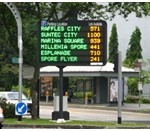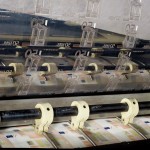Currency Supply Chain of the Future
07 July, 2013
Walk with me for a moment into the twilight zone and let us examine the potential for a currency supply chain of the future. As we all know, governments and big business have been using various technologies to track our movements and habits for many years. Whether to predict our next purchase or to protect us from criminal and terrorist acts, technology now invades every aspect of our lives. What if we could use these technologies to improve the currency supply chain?
I read a recent post in the Treasury Management Network Group on LinkedIn, which posed the question “Do Central Banks Really Know How Much Cash Is Out There?”. Although the post was referring specifically to corporate cash, it started me thinking of a better way to monitor currency-in-circulation. I have learned from various central bank projects that there are some common challenges in managing the supply chain:
- When should old banknotes be destroyed?
- When should new banknotes be printed?
- Where should regional currency inventories be maintained?
- When should banknotes be moved between regional inventory locations?
- Should Custodial Inventory Responsibility be shared with Commercial Banks and/or CIT’s?
- What incentives and penalties can be used to discourage the unnecessary movement of currency?
 In this age of pervasive technology it is ironic that these questions are answered via intense manual effort. Even then the answers are at best approximations of best practices. An interesting analogy to a possible solution can be found in Singapore. Singapore, being an island nation has had a reputation for some of the worst traffic congestion on the planet. To resolve the problem a massive the Singapore Land Transport Authority adopted an Electronic Road Pricing (ERP) system. The ERP system uses passive and active monitoring of traffic patterns in realtime to offer drivers toll-based incentives to choose alternate routes, thereby reducing congestion.
In this age of pervasive technology it is ironic that these questions are answered via intense manual effort. Even then the answers are at best approximations of best practices. An interesting analogy to a possible solution can be found in Singapore. Singapore, being an island nation has had a reputation for some of the worst traffic congestion on the planet. To resolve the problem a massive the Singapore Land Transport Authority adopted an Electronic Road Pricing (ERP) system. The ERP system uses passive and active monitoring of traffic patterns in realtime to offer drivers toll-based incentives to choose alternate routes, thereby reducing congestion.
 What if the currency supply chain of the future could utilize similar passive and active technologies to monitor currency use and demand in such a way that a central bank could monitor the supply chain via a dashboard (like air traffic control systems?). The dashboard could simultaneously recommend when destruction is necessary, when new banknotes need to be printed, where inventories are likely to grow or diminish, when inventories should be relocated and in what denominations. Also, the system could recommend when fees should be implemented and communicate those to affected parties thereby giving them incentive to discourage the movement. Additionally this Electronic Currency Supply Chain (ECSC) system could monitor external custodial inventories for denominational holdings, fitness levels, regional effectiveness and forecast demand.
What if the currency supply chain of the future could utilize similar passive and active technologies to monitor currency use and demand in such a way that a central bank could monitor the supply chain via a dashboard (like air traffic control systems?). The dashboard could simultaneously recommend when destruction is necessary, when new banknotes need to be printed, where inventories are likely to grow or diminish, when inventories should be relocated and in what denominations. Also, the system could recommend when fees should be implemented and communicate those to affected parties thereby giving them incentive to discourage the movement. Additionally this Electronic Currency Supply Chain (ECSC) system could monitor external custodial inventories for denominational holdings, fitness levels, regional effectiveness and forecast demand.
 Currency processing vendors the world over are searching for the “next big thing” in currency processing technology. Perhaps rather than looking at improving the individual pieces of their product offerings, they might consider a more holistic approach to supply chain management. Arguably many of these vendors only specialize in select parts of the supply chain and there seems to be little desire to engage in constructive coopetition. However there are a few large, multi-national vendors whose product offerings cover most (not all, yet) of the moving parts of the currency supply chain. Perhaps with some encouragement we can get them to think outside the box and propose some creative top-down methodologies that could evolve into the currency supply chain of the future.
Currency processing vendors the world over are searching for the “next big thing” in currency processing technology. Perhaps rather than looking at improving the individual pieces of their product offerings, they might consider a more holistic approach to supply chain management. Arguably many of these vendors only specialize in select parts of the supply chain and there seems to be little desire to engage in constructive coopetition. However there are a few large, multi-national vendors whose product offerings cover most (not all, yet) of the moving parts of the currency supply chain. Perhaps with some encouragement we can get them to think outside the box and propose some creative top-down methodologies that could evolve into the currency supply chain of the future.










